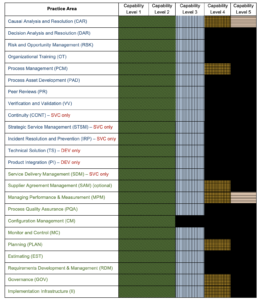What is CMMI?
CMMI is a collection of best practices used by service organizations to improve their cost, schedule, and quality results. It is organized into a roadmap that can be implemented incrementally over time.
Useful links
- CMMI for Development Summary | Changes in CMMI V3 | Formal and informal CMMI appraisals
- Custom appraisals using your criteria | CMMI for Development resource page | CMMI for Services resource page
Why use CMMI-SVC?
An organization at Maturity Level 3 is able to:
- Elicit and confirm requirements from the customer to set delivery expectations.
- Plan and estimate work accurately using historical data.
- Assess risks and opportunities internally and externally to avoid surprises and suggest potential new opportunities to consider.
- Monitor progress accurately and provide status to the customer exactly on where the project is.
- Deliver services as promised and have a method to manage and resolve issues quickly.
- Internally, prepare for adverse conditions and still provide services.
- Minimize the number of defects in all deliverables.
- Identify the root causes of selected errors so that they can be prevented.
- Learn and internally share best practices and reduce or avoid mistakes.
- Always be able to locate, use and send the correct versions of deliverables.
- Make key decisions based on an evaluation of alternatives and criteria (decision such as, proposal bid/no bid, technology selections, service changes).
- Select and manage suppliers. Track supplier performance to minimize surprises.
- Check services are meeting customer needs.
- Internally check that company best practices are followed, and if not generate corrective actions or process improvements.
- Collect service requests to determine new service offerings.
Who uses CMMI-SVC
Examples of service organizations that can use CMMI-SVC are:
- IT services
- Software as a service
- Scientific research
- Maintenance (of products, systems, facilities)
- Human resources
- Health care
- Logistics
Model Summary
The Practice Areas (PA) are summarized below.
Service Delivery Management (SDM): Deliver services in accordance with service agreements. Prepare, execute and improve.
Requirements Development and Management (RDM): a) Define the services of the group, b) trace defined services to team activities, c) verify that resources, service definition and actual work done match.
Planning and Estimation (PLAN and EST): Establish and maintain plans (major tasks, estimates, risks and resources) for service work. Perform work planning using company defined best practices and tailoring guidelines. Use organizational historical data for estimation. Identify dependencies and stakeholders for coordination, and comprehend this information into a master schedule or overall work plan. As work progresses, coordinate all key stakeholders. Use thresholds to trigger corrective action (such as schedule and effort deviation metrics).
Monitor and Control (MC): Understand the group’s progress so that appropriate corrective actions can be taken when performance deviates significantly from the plan.
Managing Performance and Measurement (MPM): Develop and sustain a measurement capability that is used to support management information needs.
Process Quality Assurance (PQA): Provide staff and management with objective insight into processes and associated work products.
Verification and Validation (VV): a) Find errors in work products and services before delivery, b) validate that the services delivered are working correctly.
Configuration Management (CM): Label and manage the versions of all key work products and customer deliverables so that the correct versions can be located, used by the team, and sent to the customer.
Incident Resolution and Prevention (IRP): Ensure timely and effective resolution of service incidents and prevention of service incidents as appropriate.
Service Continuity (CONT): Establish and maintain plans to ensure continuity of services during and following any significant disruption of normal operations.
Strategic Service Management (STSM): Establish and maintain standard services in concert with strategic needs and plans.
Process Management (PCM): Coordinate improvements. Take what is learned at the team level and organize and deploy this information across the organization. The result is that all teams improve faster from the positive and negative lessons of others.
Process Asset Development (PAD): Organize best practices and historical data into a useful and usable library.
Organizational Training (OT): Assess, prioritize and deploy training across the organization, including domain-specific, technology and process skills needed to reduce errors and improve team efficiency.
Risk Management (RSK): Assess and prioritize all types of risks and opportunities in a project and develop mitigation actions for the highest priority ones. Start by considering a predefined list of common risks and use a method for setting priorities.
Decision Analysis and Resolution (DAR): Systematically select from alternative options using criteria, prioritization and an evaluation method.
Causal Analysis and Resolution (CAR): For selected problems or issues, determine root causes and corrective actions.
The Process Group is a CMMI Partner
![]()

 The Process Group helps you improve your organization's capability to routinely meet deadlines and delivery quality expectations. We are certified CMMI appraisers / trainers and Certified Scrum Masters.
The Process Group helps you improve your organization's capability to routinely meet deadlines and delivery quality expectations. We are certified CMMI appraisers / trainers and Certified Scrum Masters. 